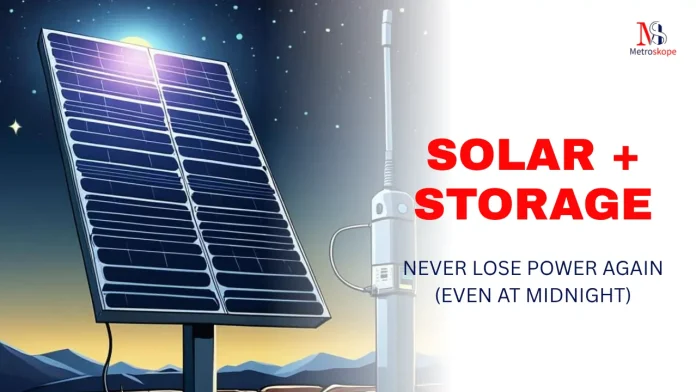The days of losing power when the sun goes down are officially over.
Solar + storage systems have revolutionized how we think about energy independence, transforming solar power from a daytime-only solution into a 24/7 reliable energy source.
With battery technology advancing rapidly and costs plummeting, homeowners can now enjoy uninterrupted electricity even during midnight blackouts, severe weather events, or extended grid outages.
The Game-Changing Reality: Solar That Never Sleeps
For decades, solar’s biggest limitation was its dependence on sunlight. Solar panels cannot produce electricity at night, leaving homeowners reliant on the grid when darkness falls.
But this fundamental constraint has been solved through advanced battery storage technology that captures excess daytime solar energy for nighttime use.
According to recent industry analysis, it’s now possible to deliver near-continuous, round-the-clock solar electricity in sunny regions.

The magic formula is surprisingly simple: match 5 kW of solar panels with a 17 kWh battery, and you can deliver a steady 1 kW of power across all 24 hours of the day in locations with adequate sunlight.
How Solar + Storage Systems Work Around the Clock
Daytime Operation: Charging Your Energy Bank
During peak sunlight hours, your solar panels generate more electricity than your home typically consumes. Instead of sending all excess energy back to the grid, solar battery storage systems capture this surplus energy for later use.
This process maximizes your solar investment and creates your personal energy reserve.
The Daily Energy Cycle:
| Time Period | Solar Panel Activity | Battery Status | Home Power Source |
|---|---|---|---|
| 6 AM – 10 AM | Moderate production | Charging begins | Solar + minimal grid |
| 10 AM – 4 PM | Peak production | Fast charging | 100% solar |
| 4 PM – 8 PM | Declining production | Fully charged | Solar + battery backup |
| 8 PM – 6 AM | No production | Discharging | Battery + grid backup |
Nighttime Operation: Your Personal Power Plant
When the sun sets, your solar panels stop generating electricity, but your home’s energy needs continue. Battery storage systems automatically switch to discharge mode, providing stored solar energy throughout the night.
Modern battery systems can power essential appliances for 8-12 hours or more, depending on your energy consumption and battery capacity.
The Revolutionary Benefits of 24/7 Solar Power
1. Complete Energy Independence
Solar + storage systems dramatically reduce your reliance on the traditional power grid.
This enhanced self-sufficiency provides security and peace of mind, knowing you have a reliable power source regardless of external factors like grid failures or utility company issues.
2. Protection Against Power Outages
One of the most compelling advantages is backup power during grid outages. When the power grid fails, a solar battery system automatically switches to battery power, ensuring that essential appliances continue operating seamlessly.
This becomes particularly valuable during natural disasters, severe weather events, or unexpected blackouts.
3. Maximum Solar Energy Utilization
Without battery storage, unused solar energy is often sent back to the grid. Solar battery storage systems allow you to store and use this energy later, making your solar panel system significantly more efficient.
This means you’re getting maximum value from every ray of sunlight your panels capture.
4. Time-of-Use Optimization and Cost Savings
Many utility companies implement time-of-use (TOU) rates, where electricity costs vary based on the time of day.
Solar battery storage allows you to optimize energy usage by storing excess energy when rates are low and utilizing it during expensive peak periods. This strategic energy management can result in substantial savings over time.
Understanding Modern Battery Technology

Lithium-Ion: The Current Gold Standard
Lithium-ion battery storage systems are widely recognized as the most effective solution for offsetting solar intermittency. These advanced batteries offer:
- High energy density for maximum storage in minimal space
- Long lifespan with thousands of charge cycles
- Fast charging capabilities during peak solar hours
- High efficiency with minimal energy loss during storage
Battery Capacity Planning
Choosing the right battery capacity depends on your specific energy needs and usage patterns. Most residential systems range from 10 kWh to 20 kWh capacity, which can power essential appliances through typical nighttime hours.
Essential Appliance Power Requirements:
| Appliance | Power Consumption | Daily Usage | Energy Needed |
|---|---|---|---|
| Refrigerator | 150W | 24 hours | 3.6 kWh |
| LED Lighting | 200W | 8 hours | 1.6 kWh |
| WiFi/Internet | 50W | 24 hours | 1.2 kWh |
| TV/Entertainment | 200W | 6 hours | 1.2 kWh |
| Total Daily Minimum | 7.6 kWh |
Emerging Battery Technologies
The storage landscape continues evolving rapidly. Battery storage capacity has grown from under 2,000 megawatts in 2020 to nearly 30,000 megawatts by April 2025.
Emerging technologies include:
- Solid-state batteries with higher energy densities and improved safety
- Advanced thermal energy storage systems for longer-duration storage
- AI-integrated management systems for optimal charge/discharge timing
Financial Benefits: The Economics of Energy Independence
Reduced Electricity Bills
Solar battery storage systems allow you to store excess solar energy and use it when grid electricity is most expensive.
This reduces dependency on the grid and can lower monthly electricity costs significantly, especially in areas with high time-of-use rates.
Protection Against Rising Energy Costs
By generating and storing your own electricity, you’re effectively locking in your energy costs and protecting yourself against future utility rate increases. This provides long-term financial predictability and potential savings.
Increased Property Value
Homes with solar + storage systems typically see increased property values, as buyers recognize the long-term benefits of energy independence and reduced utility costs.
Installation and System Sizing Considerations
Professional Assessment Requirements
Proper system sizing requires professional evaluation of:
- Current energy consumption patterns
- Available roof space and solar potential
- Local climate conditions and seasonal variations
- Budget constraints and financing options
- Local utility policies and net metering programs
Grid-Tied vs. Off-Grid Systems
Grid-Tied with Battery Backup:
- Maintains connection to utility grid for additional security
- Can sell excess energy back to grid during peak production
- Lower battery capacity requirements
- Most cost-effective for most homeowners
Off-Grid Systems:
- Complete independence from utility grid
- Requires larger battery capacity and backup generators
- Higher upfront costs but complete energy autonomy
- Ideal for remote locations or areas with unreliable grid service
Safety and Maintenance: Ensuring Long-Term Performance

Battery Safety Protocols
Modern lithium-ion batteries include multiple safety features:
- Built-in fire suppression systems
- Temperature monitoring and management
- Overcharge and discharge protection
- Professional installation and regular maintenance
Ongoing Maintenance Requirements
Monthly Tasks:
- Monitor system performance through mobile apps
- Visual inspection for any physical damage
- Check battery charge levels and cycling patterns
Annual Professional Services:
- Complete electrical safety inspection
- Battery performance testing and optimization
- Software updates and system calibration
- Warranty compliance documentation
Real-World Performance: What to Expect
Typical System Performance
A well-designed solar + storage system can provide:
- 90-95% energy independence during normal weather conditions
- 3-5 days of backup power during extended outages (with conservation)
- 20-25 year system lifespan with proper maintenance
- ROI within 6-10 years depending on local electricity rates and incentives
Seasonal Variations
System performance varies throughout the year:
- Summer: Maximum solar production, minimal battery usage
- Winter: Reduced solar production, increased battery dependency
- Spring/Fall: Optimal balance of solar production and energy storage
Cost Analysis: Investment vs. Long-Term Savings
Initial Investment Breakdown
| System Component | Cost Range | Percentage of Total |
|---|---|---|
| Solar Panels (5-8kW) | $10,000-16,000 | 50-60% |
| Battery Storage (10-20kWh) | $8,000-15,000 | 30-40% |
| Installation & Permits | $3,000-5,000 | 10-15% |
| Total System Cost | $21,000-36,000 | 100% |
Available Incentives
- Federal Solar Tax Credit: 30% of total system cost through 2032
- State and local rebates varying by location
- Utility company incentives for battery storage installations
- Net metering credits for excess energy production
The Future of Solar Storage: Emerging Trends

Market Growth Projections
BloombergNEF estimates that the global energy storage market will grow over 20% annually through 2025.
This explosive growth is driven by declining costs, improved performance, and increasing consumer awareness of energy independence benefits.
Technology Advancements
- Artificial intelligence integration for predictive energy management
- Vehicle-to-home (V2H) technology using electric car batteries for home backup
- Community energy storage programs for neighborhood-scale resilience
- Hybrid renewable systems combining solar with wind and other sources
Making the Decision: Is Solar + Storage Right for You?
Ideal Candidates
Solar + storage systems work best for homeowners who:
- Live in areas with frequent power outages
- Face high time-of-use electricity rates
- Want maximum energy independence
- Have adequate roof space for solar panel installation
- Can make the upfront investment for long-term savings
Key Questions to Consider
- What are your current monthly electricity costs?
- How often does your area experience power outages?
- What appliances are essential during outages?
- What’s your available budget for the initial investment?
- Are there local incentives or rebates available?
Your Path to Energy Independence
Solar + storage technology has fundamentally changed the renewable energy landscape, making 24/7 clean electricity not just possible, but practical and profitable.
By combining solar panels with advanced battery storage, homeowners can achieve unprecedented energy independence while protecting themselves against rising utility costs and grid instability.
The technology that once seemed futuristic is now mainstream, with costs continuing to decline and performance steadily improving.
Whether you’re motivated by energy independence, environmental concerns, or long-term financial savings, solar + storage systems offer a compelling solution that delivers power when you need it most—even at midnight.
Read More:- Solar Safety 101: Protect Your System (and Pet) in 5 Easy Steps
The question isn’t whether you can afford to invest in solar + storage, but whether you can afford to remain dependent on an aging grid system that’s increasingly vulnerable to outages and rate increases.
With proper system design and professional installation, you can join the growing number of homeowners who never have to worry about losing power again, regardless of what time the sun sets.

